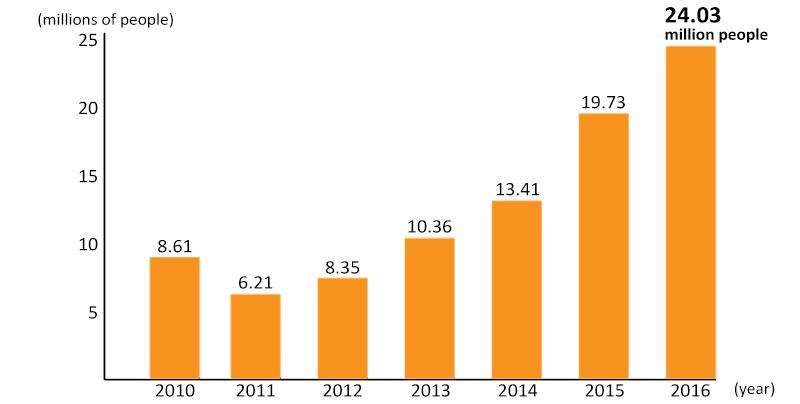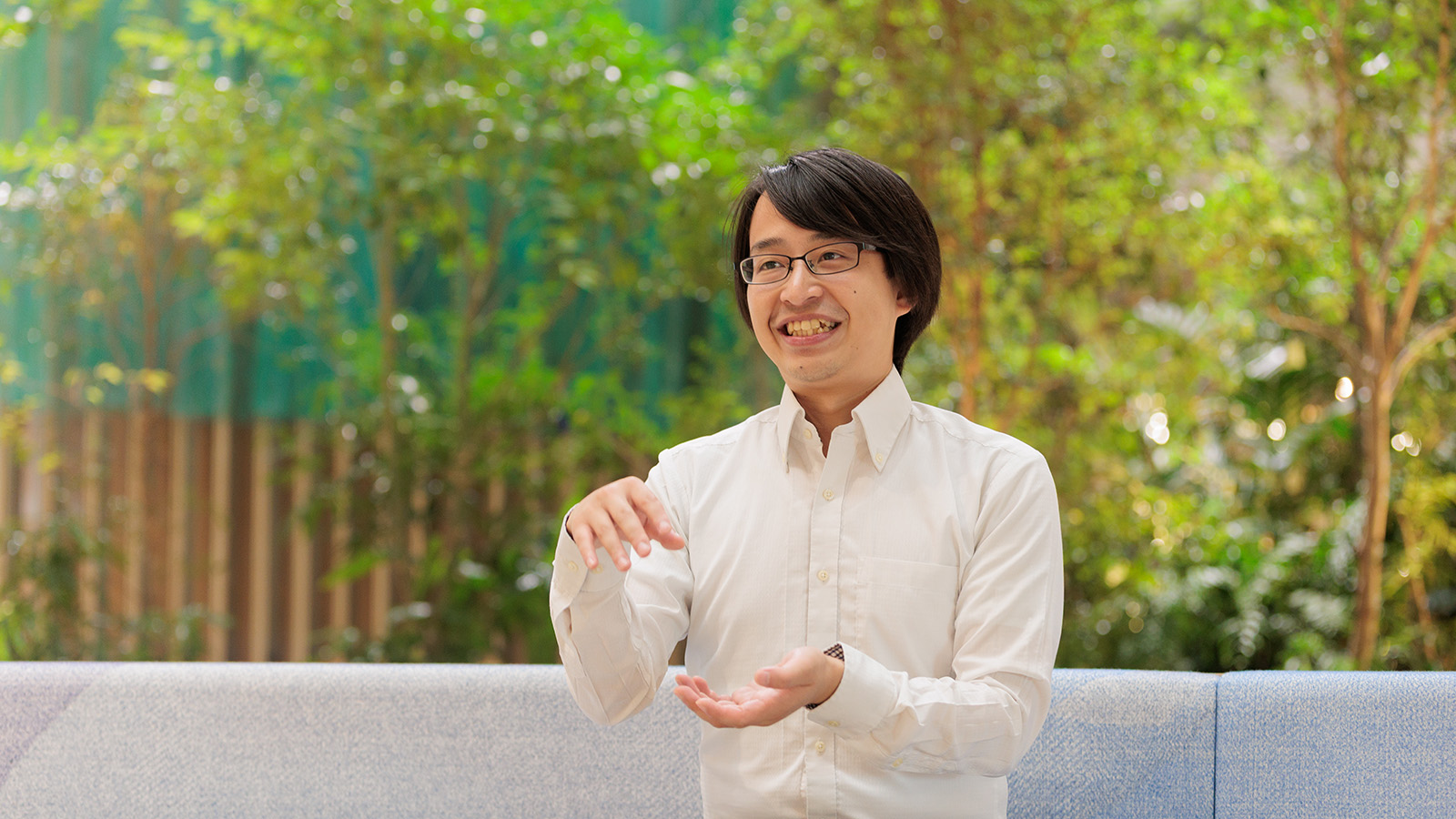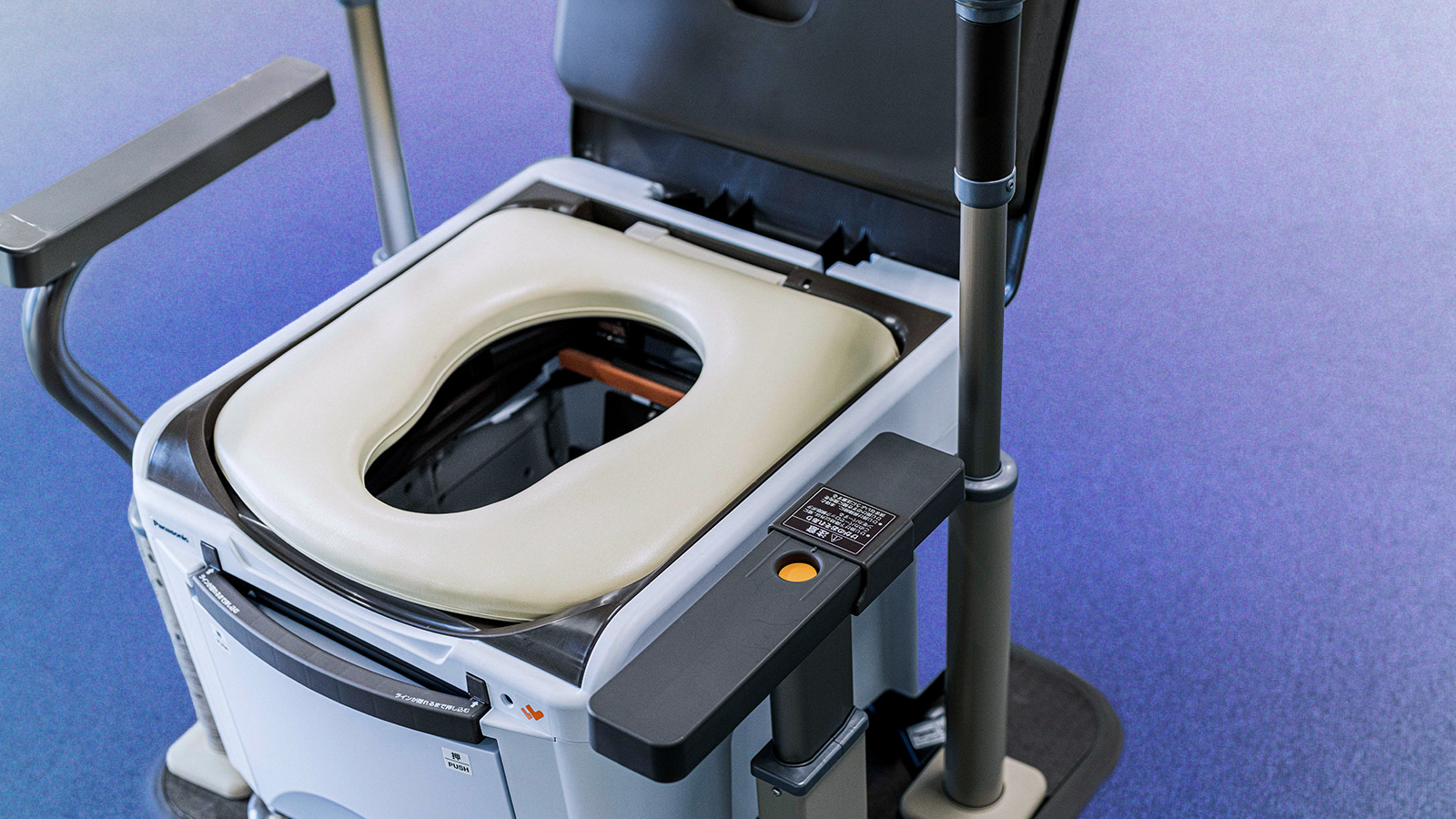
While aiming to become an advanced, world-level tourist destination, the Japanese government is conducting a variety of safety measures. Worthy of special mention among these is an effort to streamline the departure and return processes for Japanese travelers by applying facial recognition technology at Tokyo International Airport (Haneda Airport). This system, which fuses leading-edge image recognition technology with Panasonic's accumulated know-how, has an ample track record of both the "strictness" and "smoothness" that are demanded at high levels in immigration control.
As Airport Users Increase, the Completeness of the Immigration Control System Is Becoming a Pressing Issue
In March 2016, the Japanese government, which is aiming to become "a tourism-oriented country," established a "Tourism Vision to Support the Future of Japan." Focusing on the Tokyo 2020 Olympic and Paralympic Games, a goal was set of 40 million foreign travelers visiting Japan in 2020. With the consumption of these travelers estimated to be approximately 8 trillion yen, the government and private sectors plan to work together in a variety of ways. Since these numbers are approximately twice what they were in 2015, various innovations will be required to achieve them. Increasing the completeness of the immigration control system at the airports is one of them.
Actually, the number of foreign tourists visiting Japan has been rising in recent years, topping the 20 million mark in October 2016. In addition to this, the number has been growing by 4 million people per year since 2015. It is highly possible that the goal of 40 million tourists will actually be met.
Foreign Travelers Visiting Japan Each Year (Prepared from Statistics Announced by the Japan National Tourist Organization (JNTO))
In the midst of this rapid increase in foreign tourists, the strengthening of the airport immigration control system previously described is an urgent situation. Even now, there are long lines of people waiting to complete the procedures for entering Japan. Even if the inspection booths were to be increased, it wouldn't be easy to increase the number of inspectors.
With this situation in mind, the Ministry of Justice has been considering the use of facial recognition technology to streamline the procedure for Japanese people leaving and entering the country. This would allow more inspectors to be used to inspect foreign visitors entering the country, which would maintain strictness while further increasing smoothness.
The Ministry of Justice has been introducing an "automated gate" that confirms a person's identity by using a special reader to scan passports and the fingerprints of both hands. However, it is difficult to raise the usage rate. The reason for this difficulty is that "fingerprints need to be registered in advance." In addition to this, "there are a number of causes that make it impossible to read fingerprints," and "the reading method for passports is difficult." Due to this, it takes considerable time to pass through the gate. Also, there are also cases where the immigration inspectors need to respond. In other words, there were problems with usability.
"Facial Recognition" Attracts Attention for Saving Labor and Shortening Time
As a result, a system using facial recognition is gathering attention as a new method to replace fingerprint recognition. The Ministry of Justice began verification tests on facial recognition at Narita International Airport and Tokyo International Airport (Haneda Airport) in 2014.Having reached a certain level of achievement, they proceeded with a full-fledged introduction of systems using facial recognition.
Having passed through this process, the Immigration Bureau began using a new system developed by Panasonic and called the "Facial Recognition Gate." It was first introduced for the arrival processes of Japanese nationals at Tokyo International Airport (Haneda Airport), starting on October 18, 2017.
Three Facial Recognition Gates introduced for the arrival processes of Japanese nationals at Tokyo International Airport (Haneda Airport).
A High-Performance "Facial Recognition Engine" Capable of Distinguishing 10 Years of Aging
Focusing on the issues of the automated gate using the Fingerprint Recognition System, one of the main points for the Facial Recognition Gate was maximizing the usability. For example, as its name suggests, the Facial Recognition Gate recognizes the user's face to confirm his or her identity. For this recognition, it uses a facial image taken on-site and a facial image saved in an IC chip in the passport. Since there is no need for advance registration, as there was with the Fingerprint Recognition System, convenience is greatly increased.
Panasonic's facial recognition technology has a history of close to 30 years. Technical development began in the 1990s, and was used in the facial detection and facial recognition of the LUMIX digital camera series. It was also used for industrial surveillance cameras. This same technology is widely used in the security measures of large shopping malls and public institutions.
Naturally, the accumulation of this technology and know-how is also used in the Facial Recognition Gate.
"At a glance, it may seem easy to recognize a face by comparing two facial images, but this case was different," explained Hajime Tamura, who is in charge of the development of facial recognition technology at Panasonic. Passports offer a distinctive set of problems.
"In Japan, passports are used for up to 10 years. That means that there is up to a 10-year age difference between the facial image saved in the IC chip of the passport and the person's present face. Of course, there are individual differences, but in ten years, the appearance of someone's face often changes dramatically.
"Naturally, the Facial Recognition Gate dealt with things like changes in hairstyle and glasses, but there were also things like cosmetics and time-related changes, such as wrinkles and blemishes. Even with these differences, the system had to definitively confirm that it is 'this person' without a doubt. On the other hand, when there was another person who had an extremely close appearance, the system had to distinguish between the two and confirm that it was 'another person.' We worked very hard to solve this problem, but by fusing our past know-how and new technologies, we were able to achieve a high-performance Facial Recognition Engine with a high level of accuracy." (Hajime Tamura)
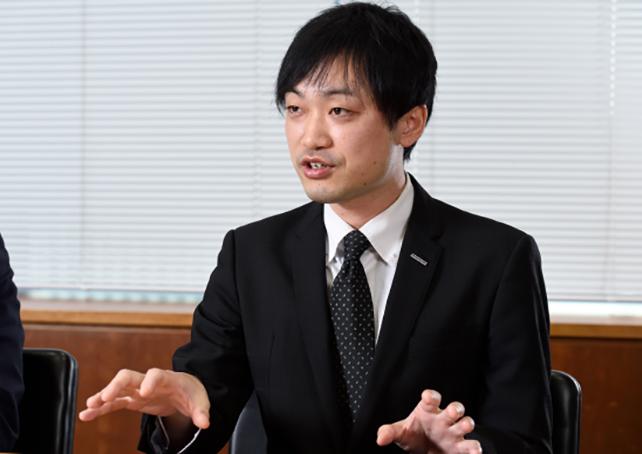
Hajime Tamura, Chief Engineer, Development Section 1, Image Solution Development Department, Innovation Center Technology Headquarters, Connected Solutions Company, Panasonic Corporation
Conversations by Engineers and Customers Are Creating New, Unprecedented Value
Unlike consumer devices like digital cameras, the Facial Recognition Gate is a product that falls under the jurisdiction of the Japanese government (Ministry of Justice). Because of this, a major point is that the level of demands is much higher than it is for consumer devices.
"While foreign tourists continue to increase, stricter inspections at the airport become more important because of problems of terrorist countermeasures and illegal immigration. The Immigration Bureau of the Ministry of Justice wanted to achieve both 'strictness' and 'smoothness' at very high levels." Wataru Ishikawa, who was in charge of sales to the Ministry of Justice, reflected on how this transpired up to the introduction of the system.
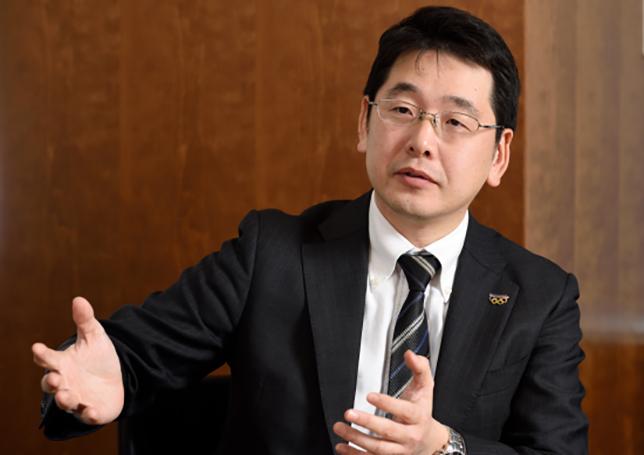
Wataru Ishikawa, Manager, Public Sales Department 3, Business Section 1, Public Sales Department, Public Systems Headquarters, Panasonic System Solutions Japan Co., Ltd.
The greatest overall effort in this project, which started in 2013, was in advancing the Facial Recognition Engine. This was necessary to meet the high demands of the Ministry of Justice by increasing accuracy and speed. The engineers also felt obligated to improve usability in order to distinguish the system from those of other companies. The people who would actually be using the Facial Recognition Gate were ordinary travelers. The need for easy-to-use service was essential because it would be the first time that many people had used such a system, and many of the users would be elderly people. This kind of attention to detail was only possible by a company with this level of expertise.
"In order to achieve this vision, the engineers needed to have a better understanding of the overall site. While carefully interviewing people to glean know-how about the surrounding site and the customer's desires, this information was disseminated to the people in charge of development. In this way, we proceeded to design and develop the system with a better understanding of the site and the customer." This is how it was explained by Takao Kubota, who was in charge of technology.
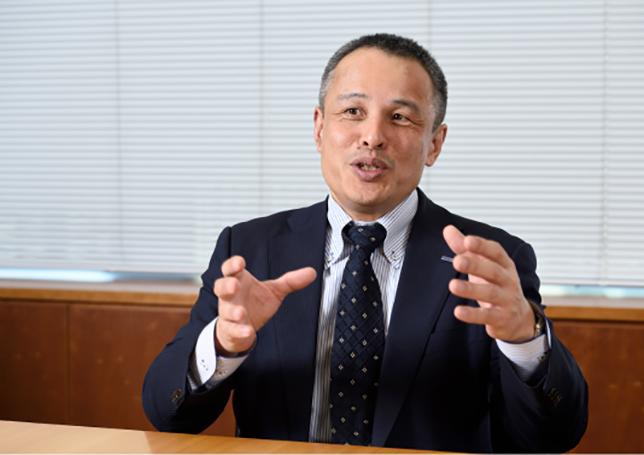
Takao Kubota, Manager, Systems Section 2, Systems Department, Innovation Center, Connected Solutions Company, Panasonic Corporation
The Facial Recognition Gate that was actually developed is extremely excellent in terms of usability. It includes a variety of aids that make it possible for first-time users or elderly people to use it without confusion. For example, a new type of passport reader was developed that could be positioned in a variety of ways in addition to its predetermined manner. The usage method is also shown on the screen to support smooth and accurate use. In terms of design as well, a space is provided to hold the traveler's baggage, and the system is designed to allow flexible changes to the layout in response to the installation location.
In the development of the automated gate, Hiroki Mitsui, who was in charge of sales to the Ministry of Justice together with Wataru Ishikawa, explains that he was able to get a strong impression of the gate through meetings with the Ministry of Justice representatives.
"The reason that so many people were able to easily use the gate after it was introduced was that we developed it by discussing with the customer what we could do in response to their needs. In the future, we plan to form an integrated team of technology and sales again and fully use this environment to co-create new value together with our customer, allowing us to provide even better service." (Hiroki Mitsui)
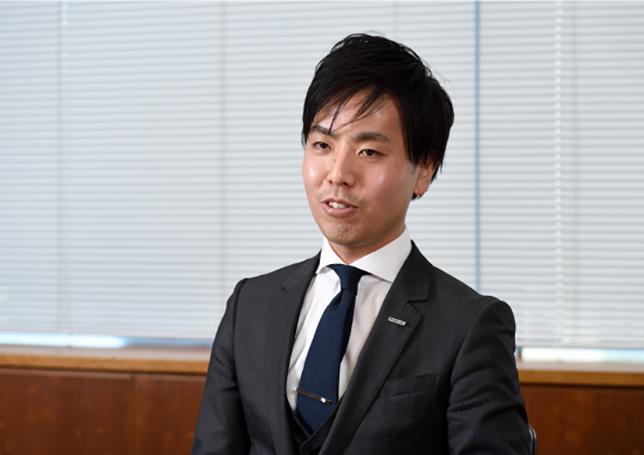
Hiroki Mitsui, Section Head, Public Sales Dept. 3, Business Section 1, Public Sales Department, Public Systems Headquarters, Panasonic System Solutions Japan Co., Ltd.
At this point, the Facial Recognition Gate is limited to use with Japanese people, however it isn't difficult to imagine using it with foreign tourists visiting Japan, or in the airports of other countries. Advanced facial recognition technologies will also be applied to a wide variety of situations other than airports. Hajime Tamura also looked to the future and added, "It must be possible to apply this technology to drivers' licenses and other forms of identification containing facial photos. And facial recognition can likely be used instead of the IC cards that employees are now using to enter and exit offices."
Just think how much more convenient our lifestyles could be with the application of facial recognition technologies. We look forward to future evolution and development.
- Reproduced from the website "Mirai-kotohajime", by courtesy of Nikkei Business Publications, Inc.
# # #
- Disclaimer:
- We would like to note that Panasonic Newsroom is not a place to address personal Customer Service issues. Even though this is not the forum, Panasonic is always eager to resolve your concerns. Our local customer services contacts can be found at Global Support or you can see our list of Social Media Accounts to find the right channel for your queries and concerns.

